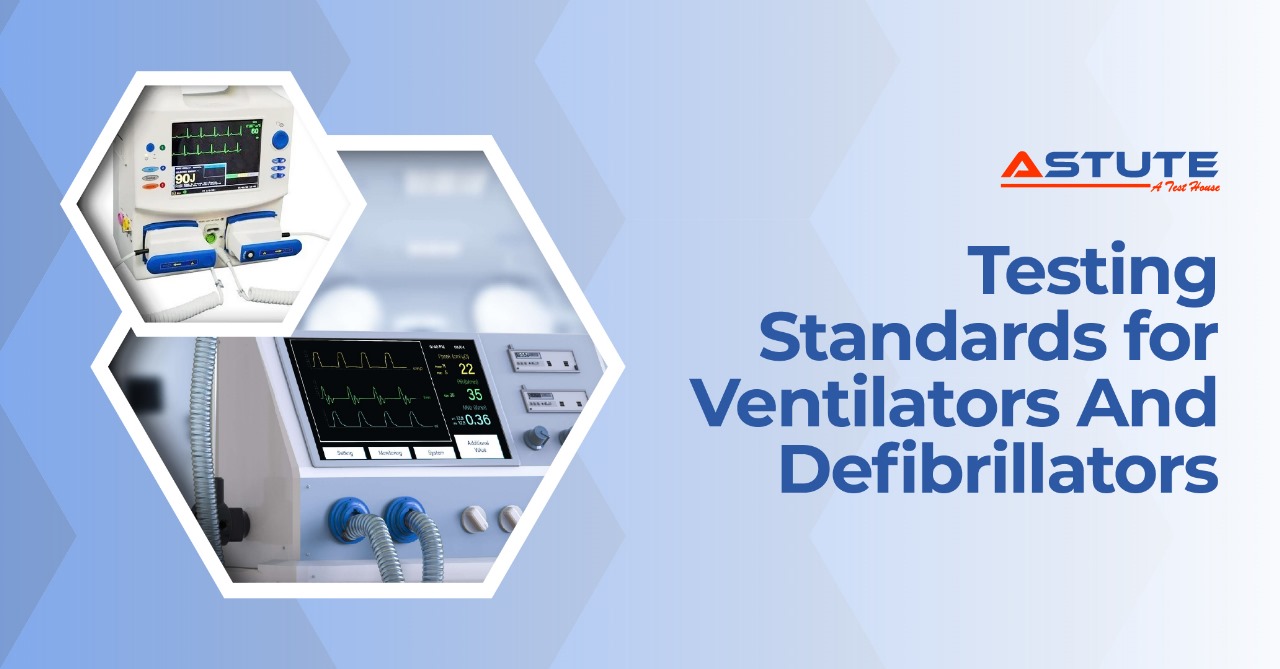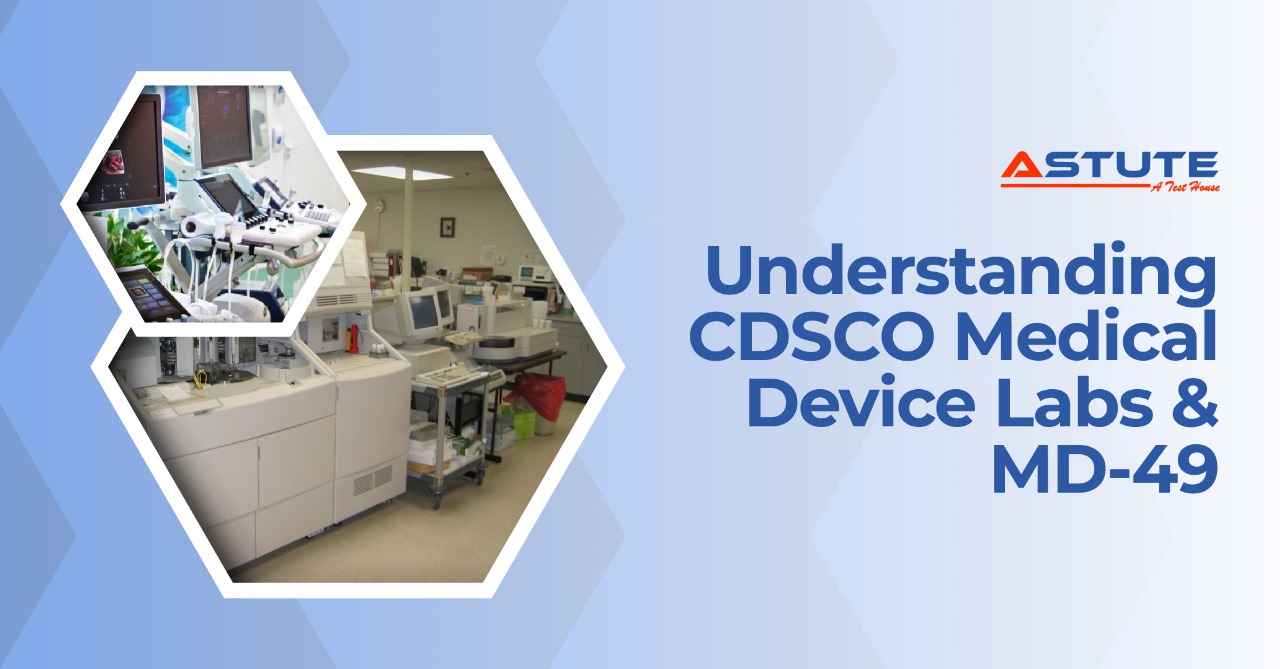Life-support devices such as ventilators and defibrillators play a critical role in emergency and ICU settings. In India, these devices fall under Class C, requiring detailed safety, performance, and risk documentation under CDSCO and BIS oversight. Understanding these compliance pathways is essential for manufacturers aiming to avoid costly delays and ensure safe market access.
This article outlines the technical standards, regulatory process, testing scope, and strategies to accelerate certification with help from experienced labs like Astute Labs.
Ventilator Testing Requirements: ISO 80601-2-12
Ventilators must comply with ISO 80601-2-12, adopted in India as IS/ISO 80601-2-12:2011. This includes:
- Essential performance: Accuracy in oxygen delivery, alarm response time, and tidal volume consistency
- Testing domains:
- Electrical safety (IEC 60601-1)
- EMC performance (IEC 60601-1-2)
- Pneumatic system accuracy (pressure, flow)
- Mechanical durability (shock, vibration, IP rating)
- Sterilization, cleaning, and reusability assessments
- Electrical safety (IEC 60601-1)
- Software validation: Required under IEC 62304 and must link directly to ISO 14971 risk controls
Testing is conducted under both normal and single-fault conditions. Ventilator software must be validated for alarm handling, sensor behavior, and power transitions.
Defibrillator Testing Requirements: IEC 60601-2-4
Defibrillators, including AEDs and advanced units, fall under IEC 60601-2-4, adopted in India as IS 13450 Part 2 Sec 4:2018. Testing includes:
- Essential performance:
- Timely and accurate energy delivery
- Synchronized cardioversion
- Arrhythmia detection with ≥90% sensitivity
- Timely and accurate energy delivery
- Key testing parameters:
- Rhythm detection and analysis algorithms
- Electrode impedance and waveform accuracy
- EMC resilience and electrical leakage
- Environmental performance and battery runtime
- Rhythm detection and analysis algorithms
Astute Labs’ medical device testing services provide full-spectrum compliance for both defibrillators and ventilators.
Common Failure Points and Mitigation
Ventilators often fail due to:
- Insufficient ESD and RF immunity
- Alarm systems failing to meet minimum sound pressure levels
- Inaccurate oxygen concentration delivery
- Sterilization issues with reusable parts
Defibrillators face challenges like:
- Low arrhythmia detection sensitivity
- Inconsistent energy delivery waveforms
- Battery voltage dips
- Electrode detachment during use
Early-stage simulation testing can prevent 60 to 70 percent of these issues before formal certification.
Risk Management File (RMF): ISO 14971 Alignment
CDSCO mandates a structured risk management file for every Class C device. Following ISO 14971:2019, your RMF should include:
- Comprehensive hazard identification
- Quantified risk estimation and ranking
- Implemented control measures and validation
- Justification of residual risk acceptance
Weak RMF linkage to test reports is one of the top reasons CDSCO raises queries or requests clarification. For help developing integrated RMF documentation, visit our guides on risk-based compliance.
Labeling, IFU, and Post-Market Surveillance
Your labeling and instructions must meet CDSCO and BIS expectations. This includes:
- Device class, model number, UDI, and manufacturer/importer details
- Symbols per ISO 15223-1 and warning indicators
- Language and layout requirements for Instructions for Use (IFU)
Post-market compliance includes:
- Adverse event reporting within 30 days
- Complaint management systems with traceability
- Recall classification and escalation procedures
- Participation in PVPI (Pharmacovigilance Programme for Medical Devices)
Why Manufacturers Choose Astute Labs
Astute Labs combines regulatory depth with technical excellence, delivering integrated testing workflows for India’s most critical medical devices. Our advantages include:
- Full accreditation: NABL, BIS, CDSCO, and QAI
- End-to-end testing: Electrical safety, EMC, mechanical, and usability
- India-specific regulatory support: Aligned to CDSCO submission formats and BIS labeling rules
- Pre-compliance diagnostics: Identify gaps early, reducing CDSCO queries by over 40 percent
We have helped multiple life-support brands reduce their certification timelines and avoid redesign cycles by combining testing with documentation alignment.
Get a Head Start on Life-Support Compliance
The compliance process for ventilators and defibrillators is rigorous, but entirely achievable with the right partner. Astute Labs works alongside your engineering and QA teams to define essential performance, build risk-aligned test strategies, and deliver complete documentation.
Our services are built for speed, precision, and regulatory readiness. Contact our compliance team today to accelerate your 2025 life-support testing strategy.
Frequently asked questions
01. Are ventilators and defibrillators regulated the same way in India?
No. While both are Class C, they are tested against different standards: ISO 80601-2-12 for ventilators and IEC 60601-2-4 for defibrillators.
02. Is clinical testing mandatory for CDSCO approval?
Not always. If your device has CE marking or FDA clearance, CDSCO may allow approval via documentation and performance equivalence.
03. What are the most common causes of test failure?
EMC issues and alarm volume non-compliance for ventilators, and rhythm detection or battery alert failures in defibrillators.
04. Is software validation required?
Yes. Any embedded software affecting patient safety must comply with IEC 62304 and link to your risk management file.




